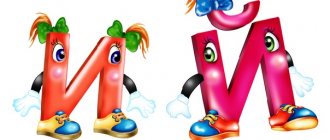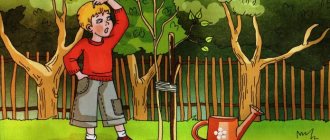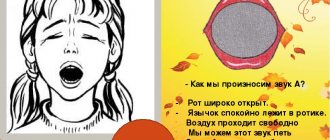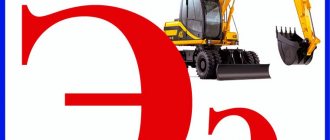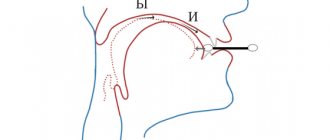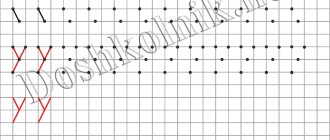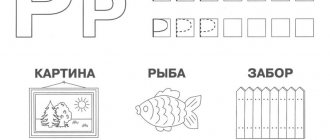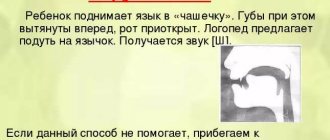How is the lesson going?
The lesson always begins with a greeting and creating a pleasant but working atmosphere. Good afternoon guys. I'm very glad to see you all. Come on, and you will smile at each other and say “hello.” Now we will quietly sit down in our seats and begin the lesson.
Definition of the sound "r" in words
Today we will get acquainted with the new letter and sound “R”. Let’s remember how letters differ from sounds? The letter can be seen and written, and the sound can be heard and pronounced. Our guest is Dunno, who also wants to be literate. I’ll read him a few riddles, and you help Dunno guess them:
- A strange beast lives at the bottom, walks backwards. (Cancer)
What is the first sound in the guess word? It can be hard - “Cancer.” Rainbow”, or can be pronounced softly – “River”.
- Coloring – grayish, Habit – furtive, Screamer hoarse, Famous person. Who is she? (Crow)
As a crow talks, let's say it together: kar-rr... Is the sound “R” voiced or unvoiced? Is it consonant or vowel? Let's denote it with a blue circle.
Children must distinguish the sound “R” and clap their hands:
- among isolated sounds: D, M, R, Zh, Z, R, R, G, R;
- among the syllables: KO, MI, RU, VA, RE, OR, PA, IR;
- Among the words: moon, cake, cat, summer, crucian carp, child, spoon, mask, TV.
Articulation exercises
Take the mirrors and stretch the tongue:
- Let's cluck like horses. We press our tongue to the roof of our mouth and slowly pull it back to make a click. Repeat 10 times.
- We ate delicious raspberry jam. Let's relax the tongue so that it becomes wide, stick it out, lick the upper lip and hide it. Repeat 10 times.
- Let's roar like a motor. The tip of the tongue should be hidden behind the upper teeth, the teeth should be slightly unclenched. We exhale a stream of air, working with the “throat”.
First slowly, then speeding up the pace, we repeat the tongue twister: “Roma was scared of the thunder, he roared louder than thunder.”
Looking in the mirror, we learn the articulatory production of sound. The tip of the tongue is slightly pressed against the tubercles behind the upper row of teeth. The lateral surfaces of the tongue are in contact with the molars. In this position, the tongue resembles a “spoon” in shape. The air is exhaled with pressure so that the tip of the tongue vibrates. The sound is pronounced with the voice.
Sound R - staging and automation
Pronouncing syllables
Continuing to control the movement of the tongue in the mirror, the sound series is spoken:
RA – RA – RA
RU – RU – RU
RO - RO - RO
You can ask the children to complete a syllable to a whole word, for example:
RU – Hand
RY - Fish
RO - Chamomile.
Warm-up
Alternating learning with outdoor games improves the perception of the material, but it is worth maintaining the focus of the lesson.
- Children stand around the teacher, imitate playing the drum, starting at a slow tempo, gradually speeding up the rhythm and increasing the strength of their voice: TARA - TARA - TARARAM.
- A poem is being read. When children hear a word with the letter “P,” they jump.
- Divide the children into two teams: “crows” and “wolves”. Crows fly, flapping their wings and cawing loudly. Wolves run into the circle growling and catch the crows. Those who are caught sit down in their places.
Parsing a letter into parts, working with a split alphabet
What does the letter "R" consist of? This is a stick with a semicircle attached to the upper half. Children draw a letter in the air, then fold it out of a paper constructor, and try to write in printed font in a notebook.
From the syllables of the split alphabet you need to make words where the letter “P” is located:
- at the beginning: fish, river, frame, radio;
- at the end: ball, painter, mosquito, carpet;
- in the middle: pie, crow, tree.
Now let’s count how many syllables are in a certain word and write the number in a notebook. Let's each come up with one sentence with any word we like. Let's name the animals that have the letter "R" in their names. Where, in what part of the word, is it located?
Summing up
Let's tell Dunno what letter and sound we learned today. Is it consonant or vowel? What color should we use to mark it? What does a hard sound sound like, what does a soft sound sound like? Well done!
Related posts:
- Teaching a child to read Teaching reading in preparation for school. When can you teach a child...
- History, signs and symptoms of dysgraphia Symptoms of dysgraphia in children and methods of overcoming it depend on ...
- What do we know about Morse code? Morse code was created to transmit short information. But use...
- The sound “Zh” - from production to automation Automation of the sound “Zh” begins with identifying the reasons that interfere with the correct sound pronunciation...
Funny poems about the letter P for children
Eraser I am an eraser, I am an eraser, Little grimy back. But my conscience is clear: I erased the blot from the sheet! (V. Berestov)
Crow - Kra! - the crow screams. - Theft! Guard! Robbery! The missing! The thief sneaked in early in the morning! He stole the brooch from his pocket! Pencil! Cardboard! Traffic jam! And a beautiful box! - Stop, crow, don’t scream! Don't shout, be quiet! You can't live without deception! You don't have a pocket. - How! — The crow jumped up and blinked in surprise. - Why didn’t you say it before?! Car-r-raul! Car-r-rman stole! (V. Orlov)
For a fish, cancer is neither a friend nor an enemy. Fish are unlikely to be afraid of cancer. The fish is afraid of the worm that is attached to the hook. (V. Lunin)
Ruff gave a gun loaded with a cork to a timid fish. Since then, the pugnacious black cancer has not started fights with her. (G. Satir)
Together with the golden cloud, the bugler wakes up. Vociferously, vociferously, the bugler sings: “The grass in the meadow is not crushed! The sun looks into the river! Let's exercise, guys! Get ready!” (V. Levin)
Pen Printed letters Very neat. Letters for writing I write myself. It's very fun to write with a pen: The letters hold each other's pens. (V. Berestov)
What's growing in our garden bed? Cucumbers, sweet peas, tomatoes and dill For seasoning and for testing. There are radishes and lettuce - Our garden bed is a treasure. But watermelons don't grow here. If you listened carefully, you would definitely remember. Answer in order: What grows in our garden bed? (V. Korkin)
About the letter R The letter R is lost. Where? On a tram, for example. Or didn't we pick her up from the yard yesterday? Dropped in a grocery store, Didn't find it behind the door in the house? Or hidden (check!) in a printed envelope? Maybe the policeman will give us the letter R? But Masha said loudly: “Our letter has been found!” Look how simple it is: Fish! Cancer! River! Rocket! (V. Tvorogova)
Why? I won’t tell anyone why tigers growl: “Gar-r-r”, Crows shout: “Car-r-r”, Horses wheeze: “Hr-r-r”, Shutters creak: “Skr-r-r”. I won't tell anyone. Why does Kenar sing: “Tew-ir-r-r”, A helicopter flies: “Dr-r-r”, A tractor roars: “Tr-r-r”, A boat floats: “Shrr-r-r”. And no one will guess. That Tigers growl, Crows scream, Shutters creak, Horses snore, To teach all the children to pronounce the difficult “r-r-r-r”!.. (P. Vysotsky)
Olesik's Trouble Olesik always had trouble with the letter "er". Says “cancer” - comes out “varnish”. Instead of "rye" - it turns out to be "lie". A puppy who was angry. He learned to growl. And now, in spite of misfortune, He pronounces “er” everywhere: “Crocodir” and “Morotok”, “Moroko” and “boxes”. At the zoo there is “roar” and “rvitsa”... Who can we learn “el” from? (N. Timchak)
We fly apart, we fly together. We roller skate. Cheerful dancers, Frisky like meteors. (V. Berestov)
Crayfish, oh, and bullies! They can't do without a fight. Every now and then they start fights among themselves. (F. Bobylev)
Thundered over the black cloud, Roared over the red steep, Let thunder rumble in the mountains! Let's go for a walk anyway! (S. Pogorelovsky)
Sound production methods
Tongue twisters for pronunciation of the sound “r”.
Basic staging techniques:
- By imitation - the child’s attention is fixed on movements, positions of the organs of articulation using visual and auditory control.
- Mechanically - using speech therapy probes, spatulas, hand tools.
- Mixed method - production from other sounds.
The period for fixing the correct sound is from 25 to 60 days. Lessons are held 2 times a week, without a speech therapist at home they study daily.
Imitation
Until the age of 6 years, pure “P” and “Pb” appear in children by imitation. The child masters articulation independently through phonemic perception, focusing on the speech of the people around him. Therefore, the pronunciation of adults should be clear and clear, without violations.
Setting "R" from the sound "D"
You can teach your child to say the letter “R”, starting from already formed sounds.
Setting from “D”:
- The child pronounces “D” loudly. The tip of the tongue rests on the alveoli of the upper palate. The tongue does not leave the palate.
- Repeat “Ddddd” without stopping. The tongue will vibrate and “DDD-RRR” will appear.
- Say the syllables DRA, DRO, DRU, DRE, DRA, in which the “R” sounds hard.
- Pronounce words that begin with “DR”, “TR”, practice pronunciation.
- Remove "D" from exercises.
If your child is unable to vibrate his tongue, you can help him by gently nudging his tongue with a popsicle stick.
Exercises from the sound “Zh”
If a preschooler pronounces “F” correctly, then when pronouncing it, you can move the tongue with a stick deeper into the mouth. A short “R” is formed. Strengthen it by repeating the exercises. After automating “R”, select words without using “F”.
Setting from the sound “Z”
The child pronounces “Z” briefly, lightly touching the alveoli with his tongue, and blows strongly on the tongue. A single-beat “P” will be heard, which then easily turns into a vibrating one.
This method is rarely used in practice, because The articulation of “R” and “Z” is different.
Exercises from the sound “C”
The child pulls “Ssssss” for a long time, then inhales through the mouth and presses the tongue to the alveoli. A short “P” will appear, which is automated through the exercises described above.
On inspiration
A distinctive feature of the above method is that the sound is caused by inhalation. Speech is built on a long exhalation, while the inhalation during speech breathing is short. But when placing “P” from “S”, the child makes a sound while inhaling air.
Ways to make the sound “r”.
Mechanical method
“P” is placed mechanically using speech therapy instruments. The child opens his mouth and raises his tongue to the sky. The speech therapist taps the alveoli with a hammer and adds vibration with a spatula. The sound is fixed with the help of exercises, vibration is practiced, first with a spatula, then without it.
Vibration of the tongue can be obtained in the following way: place a thick ball of paper (tied to a long thread) on the tip of the tongue, remove the tongue by the upper teeth and blow it off the tongue with a strong stream of air.
The mechanical method is used with caution in play so as not to injure the preschooler.
A tale about the letter R
Red-haired city One boy was teased with red hair. This boy was very worried and decided to leave home, no matter where. He went to bed early and had a dream: as if he had already left home and was walking wherever his eyes led him. He looks - the gates are standing, and on them is written:
“Welcome to Red City!” He entered and gasped.
In this amazing city, everything was red-red. Red streams flowed through red grasses and flowed into red rivers. And red rainbows hung over the rivers. Red fishermen caught fish and crayfish in these places. “The Red Waltz” was broadcast on the radio, and all the red-haired people smiled joyfully. Then a red-haired girl approached him:
"Why are you so sad?" “Everyone teases me about being a redhead,” the boy answered gloomily. “How stupid,” the girl laughed. “Come on, look at the sun, what color is it?” “Well, red,” the boy said timidly. “And we are red! This means that we are all little suns. You should be happy!..”
And then the boy woke up. He ran out into the yard, and the boys were right there: “Red-haired, red-haired, freckled!” And he just laughed and slyly winked at the red sun...
(G. Yudin)
Assignment: Printed letter P for preschoolers
Look at the letter P, write it in the air. Draw a stick (vertical) and turn it into the letter R.
In cases where the child is asked to write a whole line of a letter, syllable or word, the adult gives a writing sample at the beginning of the line. If a preschooler has difficulties, then an adult can draw two approximate lines, or put reference points that the child will connect with lines, or write the entire letters, and the child will simply circle them in a different color. Calligraphy should not be required at this stage of training.
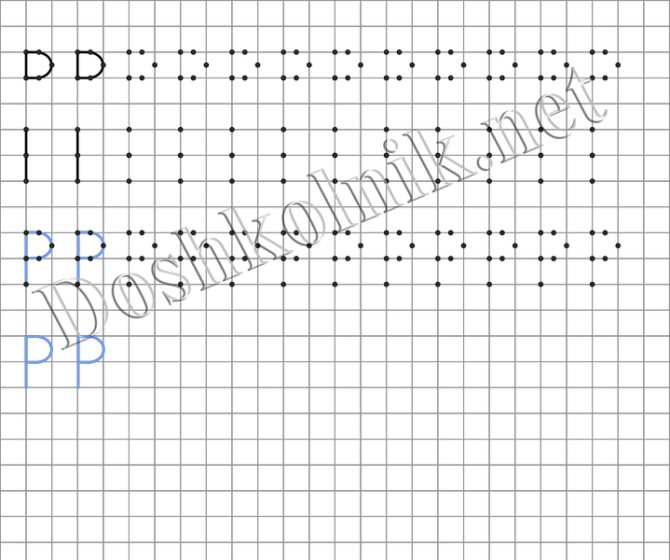
Print
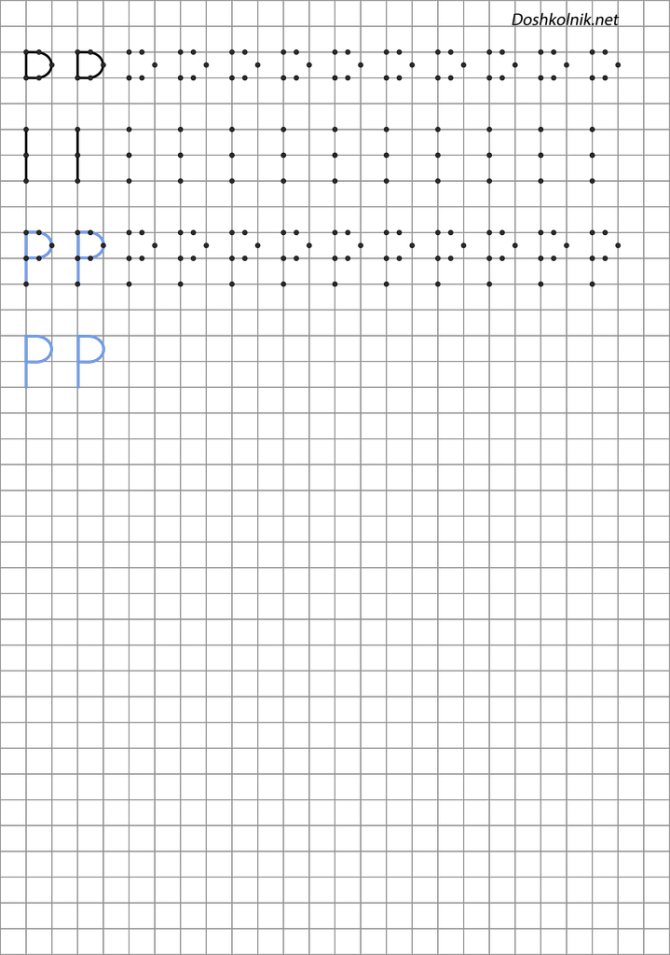
Riddles for children starting with the letter P
Along the wave, along the wave Music floats towards me. (Radio)
There is a beautiful chest, You can’t touch it - it’s silent. And as soon as you turn the hands, He will speak and sing. (Radio)
The painted rocker hung above the river. (Rainbow)
People live under water and walk backwards. (Crayfish)
Not a feather, not a wing, But faster than an eagle. As soon as it releases its tail, it will rush to the stars. (Rocket)
It is bitter in haymaking, and sweet in frost. What kind of berry? (Rowan)
My cheeks are red, my nose is white, I sit in the dark all day, And my shirt is green, It’s all in the sun. (Radish)
Runs in the summer. Sleeps in winter. Spring has come - I'm running again. (River)
It flows, it flows, it won’t flow out, it runs, it runs, it won’t run out. (River)
He has a lot of teeth, but he doesn't eat anything. (Comb)
You enter through one door and exit through three. You think you left, but in fact you entered. (Shirt)
The steel pipit runs across the white field, leaving black tracks behind it. (Pen)
Round, but not a ball, Yellow, but not butter, Sweet, but not sugar, With a tail, but not a mouse. (Turnip)
A new vessel, but it’s all full of holes. (Sieve)
Whoever touches him clings to him. (burdock)
In the morning the beads sparkled and covered all the grass. And we went to look for them during the day - We search and search, but we won’t find them. (Dew)
Four guys are sitting in one fur coat, and the fifth is in a fur coat and stands aside. (Hands in mittens)
I’m not sitting on a horse, but on a tourist’s back. (Backpack)
Autumn has come to our garden. The red torch was lit. Here blackbirds and starlings scurry about, And, noisily, they peck at him. (Rowan)
Reasons for incorrect pronunciation

A set of art exercises.
Forms of rotacism:
- Distorted pronunciation.
- Lack of sound in the child's speech.
- Replacing one sound with another.
Causes:
- Disorders of articulatory motility and the structure of the articulatory apparatus: short frenulum, narrow or enlarged tongue, malocclusion, lack of teeth, high palate.
- Violation of central regulation of breathing. The rhythm and coordination of inhalation and exhalation are disturbed. Exhalation occurs through the nose during throat pronunciation. The defects are caused by changes in muscle tone, limited mobility of the muscles of the larynx, soft palate, vocal folds, tongue and lips.
- Pedagogical neglect. The child does not hear literate speech in everyday situations; there is no literacy training. Adults consciously imitate his pronunciation, changing sounds, and do not correct incorrect sounds. They do not read literary works to a preschooler, nor do they have long conversations with him.
- Phonemic hearing impairment. The child does not distinguish phonemes of his native language, mixes them up, and does not understand the speech of others well.
Speech breathing problems
Speech breathing is the basis of spoken speech. It is responsible for voice-forming and articulatory functions. Speech breathing is the ability of a person to take a short, deep breath and distribute the air when exhaling while simultaneously pronouncing various sounds. Inhalation is 5-8 times shorter than exhalation. The long-term output is where speech is formed. With correct speech breathing, the child speaks clearly and expressively, observing pauses.
Preschoolers do not control themselves, they begin to speak while inhaling or on the residual output, and take in air before pronouncing each word. This affects correct pronunciation. If the child does not pronounce “R”, correction work should begin with breathing.
Hearing impairment
Phonemic hearing is the ability to distinguish, analyze and differentiate heard phonemes. From birth, children master their native speech by imitation. By the age of 4, a preschooler has developed the technique of pronunciation of all sounds, except sonorous ones.
Impaired phonemic hearing (dyslalia) complicates the perception of oral and written speech in school education, therefore, correction of defects is necessary as soon as they are detected.
Speech therapy exercises for the development of phonemic hearing, which parents can do independently:
- The adult names a series of sounds, and the child claps his hands when he hears the one in question.
- The adult claps his hands or taps a pencil in a rhythm that the child must repeat.
- The adult dictates sound combinations, the child repeats them.
- The adult shows the pictures, the child chooses those with the hidden sound.
- The adult names the words correctly and incorrectly, the child claps his hands when he hears the correct option.
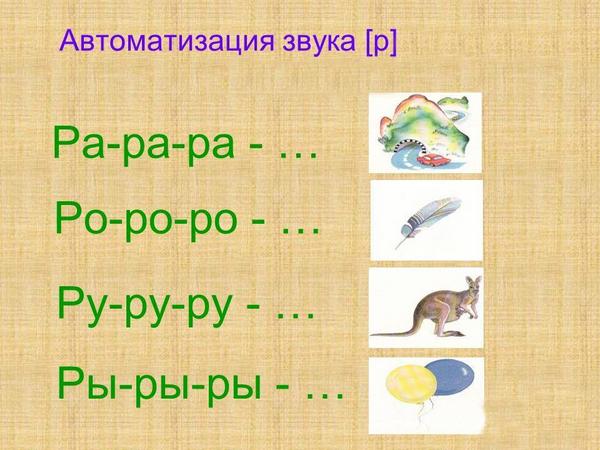
Automation of the letter "P".
Insufficient development of speech organs
Immaturity of the speech apparatus is the main cause of pronunciation problems in preschool children. The speech apparatus consists of 2 sections: central (brain sections) and peripheral (tongue, lips, soft palate, lower jaw). Brain disorders are diagnosed and corrected by a neuropsychologist. Defects in the articulatory apparatus are eliminated by a speech therapist-defectologist in a playful manner.
Individual structure of the frenulum
A shortened frenulum and anomalies in its location are a defect of the oral cavity that occurs in early childhood. The problem can be effectively solved surgically; if you contact a specialist in a timely manner, the hypoglossal ligament is stretched with the help of exercises and speech therapy tools.
When correction is needed
The sound “R” is one of the most difficult sounds in a child’s speech development. It belongs to the category of sonorants, in which there are more vocal tones than noise.
Experts put “P” last, when all other sounds have already been correctly formed and consolidated. The production of “R” begins after 5.5-6 years. Until this time, a violation in his pronunciation is the age norm.
In some cases, it is worth contacting a speech therapist from the age of 4, when “R” appears in speech, but does not manifest itself correctly. In this variant, the child does not replace “R” with other sounds (“L”, “V”), but tries to pronounce “R”, but with disturbances in the articulatory apparatus.
Norm for pronunciation of “R”:
- lips are relaxed;
- distance between teeth 4-5 mm;
- the tip of the tongue rises to the upper gums;
- the tongue vibrates in the air stream;
- the middle part of the back of the tongue arches;
- the back of the tongue is directed back, pressed against the palate;
- the side edges are pressed upward;
- The vocal folds vibrate when speaking.
Violation of the pronunciation of hard “P” and soft “Pb” in defectology is called rhotacism or pararotacism. In Soviet times, these violations were called burrs.
The main types of rhotacism that require correction:
- Velar. The tip of the tongue is lowered down and does not participate in articulation. The tongue is tense and pushed back. There is little voice in pronunciation, a lot of air. The sound is guttural and loud.
- Uvular. The tongue vibrates in the air stream. The sound is soft, quiet, smooth.
- Nasal. The air is directed into the nose, there is no vibration.
- Bilabial. Only the lips, without the tongue, take part in articulation.
- Slotted. The tongue is directed upward and forms a gap with the soft palate. The sound changes to “Z” or “Zh”.
- Interdental. The tongue is between the teeth.
Stages of correction of violations:
- Preparatory.
- Sound production.
- Automation.
- Differentiation.
- Consolidation in speech.

